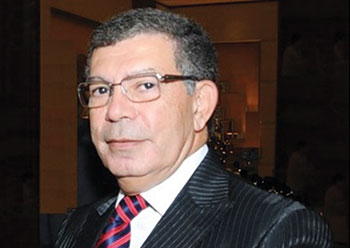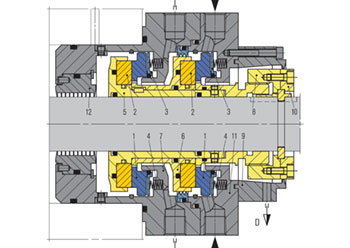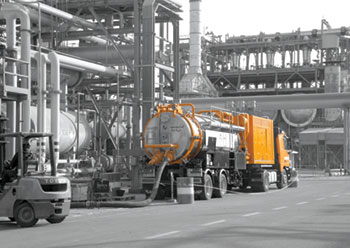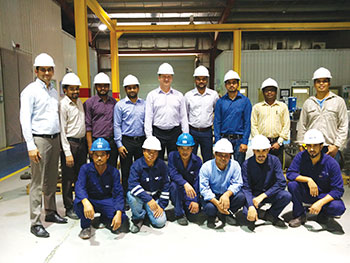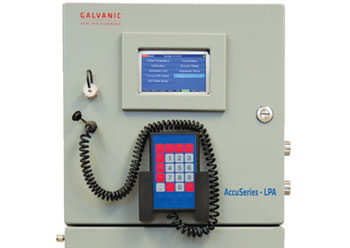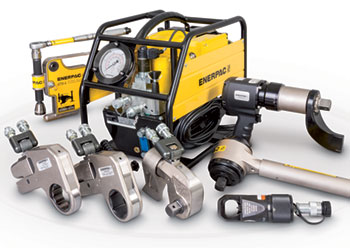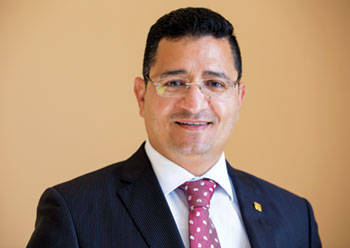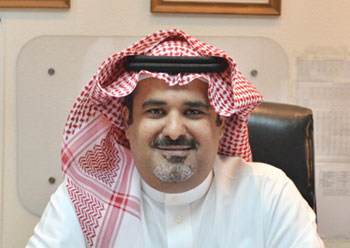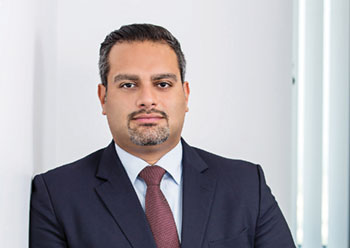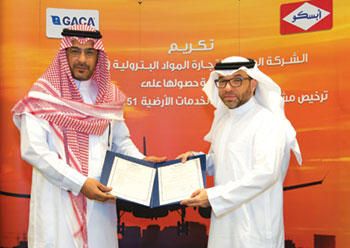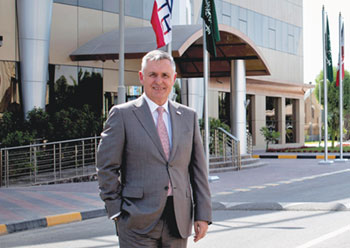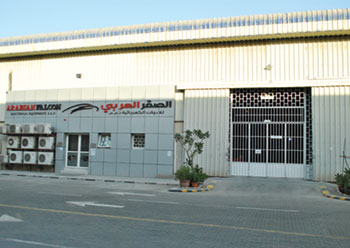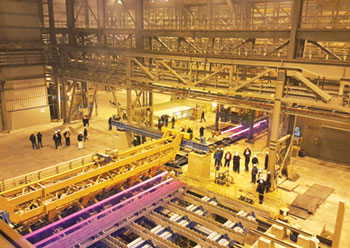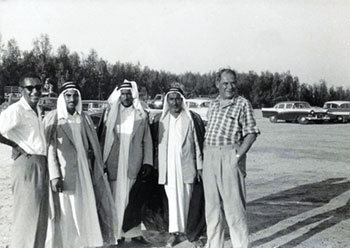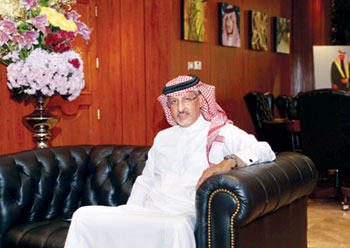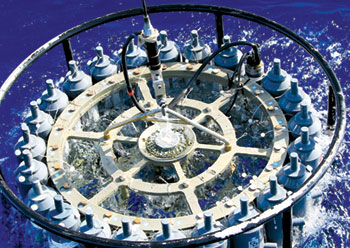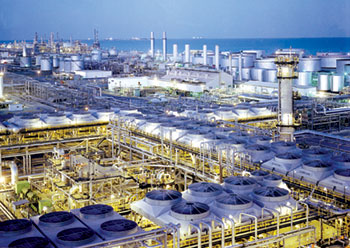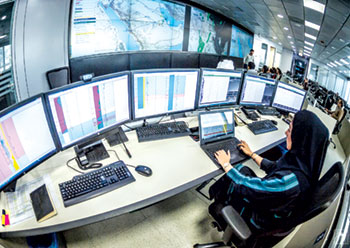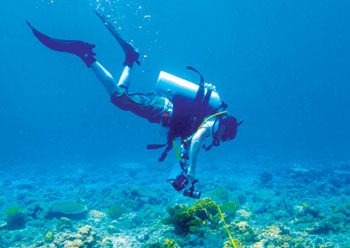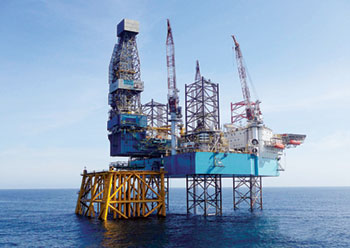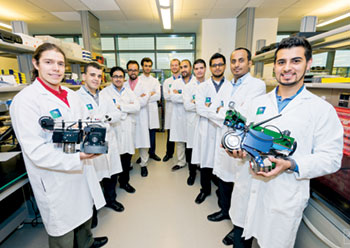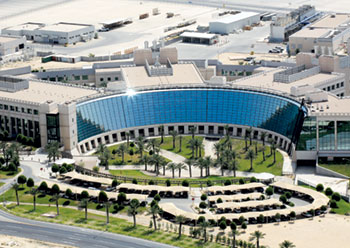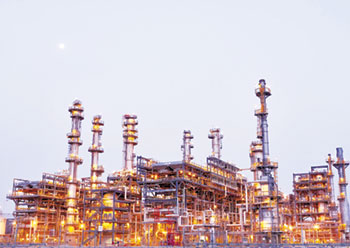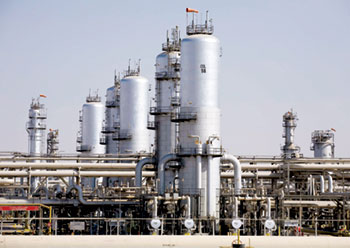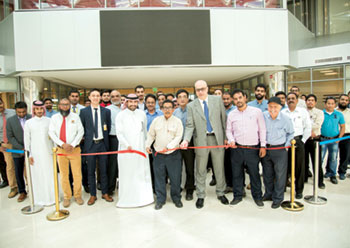
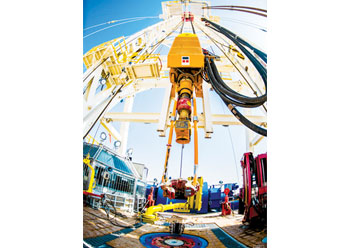 A drilling rig designed in-house
A drilling rig designed in-house
Aramco remained committed to discovering new conventional and unconventional hydrocarbon resources across the kingdom using new technologies
For 85 years, Saudi Aramco has been entrusted with the stewardship of the kingdom’s oil and gas reserves. In this time, Aramco has grown to become the world’s leading producer of crude oil and condensate.
Over the decades, Aramco has matured its understanding of the kingdom’s geology and built an integrated network of oil and gas production and processing facilities. By combining technologies developed in-house with leading industry practices, Aramco enhances its reserves base and optimises production from Saudi Arabia’s reservoirs.
EXPLORATION
Exploration has been the cornerstone of Saudi Aramco since the kingdom first granted a concession to Aramco’s predecessor, Standard Oil of California, in 1933.
Decades of onshore and offshore exploration in Saudi Arabia have resulted in an extensive portfolio of oil and gas fields that includes the world’s largest onshore and offshore oil fields (Ghawar and Safaniyah, respectively).
This accumulated knowledge and expertise enables Aramco to replace reserves through new discoveries, the delineation and reassessment of existing fields, and revisions of reserve estimates in producing reservoirs and fields.
Throughout 2017, Aramco remained committed to discovering new conventional and unconventional hydrocarbon resources across the kingdom, aided by the development and deployment of data acquisition and processing technologies.
Aramco’s unconventional gas exploration programme targeted three areas: Northern Arabia, the South Ghawar area, and the Jafurah Basin east of Ghawar. In the Red Sea, using an autonomous system that deploys seismic nodes on the seabed via reinforced armored rope, Aramco reduced the costs of 3-D seismic data acquisition in Aramco’s survey of two blocks measuring 800 square kilometres (km) and 900 square km.
The choice of locations for the 3-D seismic survey was informed by a large-scale hydrographic survey – a first for these waters. Aramco anticipate the results of the survey will help optimise field operations and facilities, including rig movements, laying of pipelines, and supply vessel routes.
The kingdom ended 2017 with proved reserves in the fields Aramco operates of 332.9 billion barrels of oil equivalent.
NEW DISCOVERIES
Crude oil and gas exploration activities during 2017 resulted in the discovery of two new oil fields and one new gas reservoir. The new oil fields discovered in 2017 were: Sakab, southeast of Haradh, and Zumul, in the Rub’ Al Khali.
The new gas reservoir discovered in 2017 was Jauf, in the Sahba field.
 |
The Berri gas plant |
Oil production: The International Energy Agency’s (IEA) World Energy Outlook 2017 New Policies Scenario estimates that global energy needs will expand by 30 per cent between today and 2040. With petroleum energy resources expected to form a key component of the world’s energy mix for the foreseeable future, Aramco continues to invest in its capability to meet current and projected future demand.
Aramco has consistently produced five grades of Arabian crude oil. These grades, and the wide range of blends that can be produced using them, are compatible with most refineries around the world.
This compatibility, combined with Aramco’s flexible crude oil production capacity, enables Aramco to quickly respond to increases in market demand for crude oil in general and to fluctuations in demand for specific grades.
In 2017, Aramco produced an average of 10.2 million barrels per day (mbpd) of crude oil, including blended condensate. Aramco’s production strategy is guided by four interlinked considerations:
• The crude oil grades available;
• The long-run value of different crude oil slates;
• Aramco’s ability to sell the crude oil grades in strategic markets; and
• The near-term requirements based on a long-term assessment of future performance.
To execute its production strategy, Aramco focuses on completing technical assessments for producing fields and exploiting potential synergies through the integration of subsurface computational models with surface facility networks. And because Aramco’s principal oil fields are linked with its extensive network of integrated facilities, Aramco has the flexibility to send crude oil to multiple plants for processing, stabilisation, and shipping.
Given the scale of Aramco’s reserves, even small percentage increases in recovery rates and production efficiency can significantly boost long-term supply.
In 2017, Aramco pursued a host of initiatives to maximise oil recovery, including advanced well completion technologies, artificial lift optimisation, and debottlenecking of production systems. Aramco continued efforts to develop secondary reservoirs, such as ‘Ain Dar and Lower Fadhili, and to optimise surface facilities.
For example, Aramco upgraded offshore platforms, installed new tie-in platforms, and replaced key trunk lines in its Safaniyah field. Aramco also stayed on course to increase the plant capacity of Aramco’s Khurais facility by 300,000 bpd in 2018.
Aramco completed a major project to de-mothball one of the gas-oil separation plants (GOSPs) at Aramco’s offshore Zuluf field. Production from GOSP-3 was suspended in 1995. During a six-month programme, Aramco inspected, repaired, and installed new equipment and utilities to bring GOSP-3 safely back online to sustain the field production capacity at 800,000 bpd of crude oil.
GAS PROCESSING
The expanding industrialisation of Saudi Arabia, and the increasing use of cleaner burning natural gas for power generation and seawater desalination, and as feedstock for the petrochemicals sector, provide opportunities for Aramco to create significant additional value beyond crude oil.
In 2017, Aramco made progress on several new gas processing plants. Designed to boost supplies of natural gas, the plants are expected to enable increased exports of higher value liquids, provide feedstock to the petrochemical industry, and reduce domestic reliance on liquid fuels for power generation.
 |
The Manifa oilfield |
Additionally, the increased use of gas is expected to help lower greenhouse gas emissions and improve air quality. In 2017, Aramco processed an average of 12.4 billion standard cubic feet per day (bscfd) of raw gas and supplied 8.7 bscfd of natural gas with an energy content of 1,080 Btu per standard cubic feet (scf).
In 2017, Aramco readied its Midyan nonassociated gas field in northwestern Saudi Arabia. The facilities in the field are designed to produce 75 mmscfd of natural gas and 4,500 bpd of condensate.
This gas will be used to displace liquid fuels for power generation. Aramco completed wells toward the development of the Hasbah-Khursaniyah increment designed to feed the Fadhili Gas Plant, which is designed to process 2.5 bscfd of raw gas. The gas from the Khursaniyah field is planned to feed the specially designed cogeneration plant that can handle low Btu gas. Aramco made significant commitments to improve production from existing gas fields and expand gas processing capacity, including:
• Expansion of the gas processing capacity of Aramco’s Hawiyah Gas Plant by 1.1 bscfd. The new gas processing facilities, expected to be on-stream in 2021, are anticipated to raise total production capacity of the plant to approximately 3.6 bscfd, making it one of the largest gas processing facilities in the world; and
• Commencement of engineering, procurement, and construction of a natural gas liquids (NGL) deep recovery train at Aramco’s ‘Uthmaniyah Gas Plant to recover ethane and other NGLs from the natural gas produced from the ‘Uthmaniyah plant and from the Hawiyah Gas Plant expansion.
In 2017, Aramco achieved the following in its three unconventional gas exploration focus areas:
• In northern Arabia, Aramco achieved raw gas production while reducing drilling costs through optimised well design and drilling practices, and made available 55 mmscfd of natural gas to the Wa’ad Al Shamal Industrial Complex.
• In South Ghawar, Aramco completed wells that showed high gas and condensate flows while also reducing drilling costs through well design optimisation and the application of fit-for-purpose technologies.
• In the Jafurah Basin, Aramco completed a number of wells and reduced drilling costs through improved well design and execution.
Upstream R&D highlights: Saudi Aramco is dedicated to achieving technology breakthroughs that enables it to meet the needs of its customers more efficiently and cost-effectively while helping to minimise the environmental impact of the company’s activities.
Aramco is harnessing the power of the Fourth Industrial Revolution through its use of Big Data and supercomputing, and through ongoing investigations into nanotechnology applications.
Aramco’s upstream R&D addresses key oil and gas challenges: Improving seismic processing and analysis, increasing the effectiveness and efficiency of gas exploration, optimising enhanced crude oil recovery methods, raising crude oil recovery rates, enhancing oil well productivity, and lowering production costs.
Aramco’s upstream research activities are primarily performed in-house, with support from Aramco’s Global Research Network research centres in Houston, Boston, and Beijing, and from Aramco’s technology offices in Aberdeen, Scotland and Delft, the Netherlands.
Highlights from Aramco’s upstream R&D programmes in 2017 include the following:
Aramco continued to increase the power and speed of GigaPOWERS, its parallel oil and water enhanced reservoir simulator, and TeraPOWERS, its next-generation reservoir and basin simulator, to improve the company’s computational modelling. These enhancements improve the resolution of the models, giving Aramco’s petroleum engineers a better understanding of reservoir mechanics to enable maximum recovery and sustainable production for the long term.
Aramco developed GeoDRIVE, its next generation, integrated seismic imaging platform that enables ultra-high resolution subsurface mapping and characterisation, and tested the platform in collaboration with the King Abdullah University of Science and Technology (Kaust). Aramco’s geophysical expertise, integrated with the power of Shaheen II, a Kaust supercomputer, successfully produced a 3-D image of subsurface geologic layers at a record resolution of 7.5 metres.
 |
The Tanjib oilfield |
This capability will enhance Aramco’s understanding of challenging subsurface environments and help optimise drilling for exploration and production. Aramco continued monitoring the performance of its multi-well demonstration project in ‘Uthmaniyah, with the goals of sequestering carbon dioxide (CO2), developing related technologies, and enhancing oil recovery. To assess the effectiveness of the field pilot, the migration of the subsurface plume from the injected CO2 is being tracked through 4-D geophysical monitoring, interwell tracer tests, geochemical sampling, and timelapse logging. The crude oil production response due to CO2 injection continued to show positive results.
Aramco’s state-of-the-art Advanced Geosteering Centre in Dhahran enables real-time monitoring of drilling rigs hundreds of kilometres away to achieve precise, optimal well placement. Live drilling and downhole data is transmitted by satellite from rigs to the Advanced Geosteering Centre where teams of experts analyse the data to make realtime decisions.
Geosteering allows Aramco to position wells for maximum reservoir contact, resulting in enhanced well productivity and reduced development costs. In 2017, Aramco’s Geosteering programme achieved 93 per cent reservoir contact efficiency. Smart Flood uses injected seawater with ionic compositions that have been optimised to enhance the "sweep" of oil in carbonate reservoirs and improve recovery rates. In 2017, Aramco completed tie-in activities and commissioned multiphase flow meters at its ‘Uthmaniyah Smart Flood demonstration project.
Aramco is exploring the use of seawater for fracturing operations to minimise the use of freshwater resources. It completed a field trial in Haradh and three more field trials are planned for 2018. Targeting improved well site safety, as well as significantly reduced field operation costs and downtime, Aramco continued its field trials of a cable deployed electric submersible pump (ESP). This technique enables the rapid deployment of ESPs using the pump’s power cable, rather than a workover rig.
In 2017, Aramco completed two installations, with a third planned for 2018. It also progressed preparations for a field trial of a slimmer version of the technology.
Nanotechnology shows the potential to enable the monitoring and analysis of reservoir performance – and possibly intervention – directly from within the reservoir.



































































